The room was getting warmer, the air palpable, and the bidding hitting levels higher than I hoped for. I had no idea who was bidding against me in the crowded banquet room Saturday night in St. Augustine, Florida, at the Professional Bowhunters Society (PBS) Biennial Gathering, but I knew my limit was soon approaching.
“You in or out, Teej?” one of the spotters yelled at me.
I waited a few seconds, then nodded. I was contemplating my next move when I heard “Sold!” My wife patted my leg and said, “I hope you enjoy your gator hunt!”
I have wanted to bowhunt alligators for many years, but never figured out how to do it without owning a boat, driving clear across the country, and spending more time than I could allow trying to figure out the entire procedure on my own. Enter friends Terry Receveur, Bill Terry, and Bo Slaughter, all PBS members who have been doing this for many years. Terry had donated his services for the bowhunt, and I fulfilled my duty by donating a couple of grand to the organization. Now, I just had to draw a license and tag.
It was two years later, this past June, when I received an email from Terry informing me that we were a go for August, Covid-19 or not. Eight gator tags had been secured for our group. Not having any preconceptions about what was to take place, save for Bill Terry telling me it would be more fun and excitement that I could imagine, I just had to get there.
I booked a flight from Boise to Orlando three weeks early. However, American Airlines cancelled my flights—three times. It wasn’t until two days before I needed to be there that I was finally able to get a flight to Orlando on time. Getting home would be another question, as all the airlines were changing flights multiple times a day. Trust me when I say this was not a good year to fly, as I’d had several problems getting to and from Alaska for our annual salmon and halibut fishing trip two months earlier.
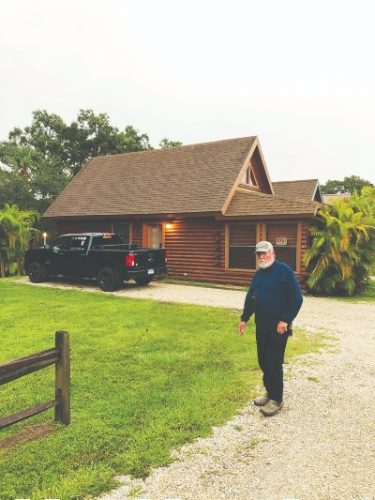
Bill Terry in front of the cabin on Lake Okeechobee that he, Bo Slaughter, and T.J. stayed in.
Bill and Bo picked me up at Orlando International, and we made our way down to Lake Okeechobee where we set up in a quaint log cabin on a slough by the lake. Terry showed up and set our itinerary for the next seven days. It was going to be fast and furious, but I was ready for the adventure.
Our window to bowhunt alligator was three days away, so to start our warmup the next morning our group, which included Terry’s son Tyler and his wife Sierra, Terry’s brother Tim, and Kevin Clark, headed out for a few hours of bass fishing. After that, it was lunch and off to bowfish armored catfish, something I knew little about.
Armored catfish—sailfin catfish—are members of the largest family of catfish, super family Loricariidae of the order Siluriformes. There are 92 genera, with some 680 species. They originated from the freshwater habitats of Panama, Costa Rica, and tropical and subtropical areas of South America. If you are a lover of home aquariums, these are members of the same family as the small, dark algae eaters that most people have to help keep their tanks clean and are sold as plecos or suckermouth catfish. They are noted for having bony plates covering their bodies and, well, suckermouths.
Rumor has it that because of the high content of organic material in Lake Okeechobee, leading to visibility of three feet at best in most areas and hurting the once world-class bass fishing that Okeechobee is famous for, these algae eaters were put into the lake to help clean it up. It appears that it didn’t work, so now they are treated as an invasive species, providing a fantastic opportunity for sportsmen.
Not having any knowledge about them, I was excited to see them up close and personal, which didn’t take long. I was allowed the first shot from our boat, which Terry was piloting, and made a direct hit. Upon getting the fish to the boat, I was amazed by the color scheme and bony armor this prehistoric looking fish had. I wanted to have one mounted, as they are without a doubt one of the most interesting fish I’ve ever arrowed. The word was they do not skin well, and you would need tin shears to clean them as the plating is very tough. I thought they might be good eating but was told that they were not table fare, so we gutted them and tossed them to the alligators at the end of the day.
The following day was much the same: in the water at sunup, out at sundown. But this day we ran into some new game. I was with Terry and his son and daughter-in-law again, and we were into the armored catfish right out of the dock, each taking turns to shoot.
Shortly after noon, Sierra spotted a giant tilapia and arrowed it. I was amazed by the size of the fish, as most of the farm-raised ones I see in the Vietnamese markets I shop in are less than a third the size of the one Sierra held up. Within a few minutes, we oozed by two more of them in dark, murky, shoreline water, and I ran an arrow through one. Beautiful fish, they are considered good eating as opposed to farm-raised tilapia fed on God knows what!
Shortly afterward, I was on point when a school of a half dozen giant mullet slipped by and I sent an arrow through one’s head. It was the largest mullet any of us had ever seen. Tyler and Sierra both wanted to bag one as well, but we couldn’t find any again before it was time to head back for dinner. Two days into the trip I had already added three new species to my bowfishing career, and tomorrow it was time to hunt what we were mainly there for, the American alligator.
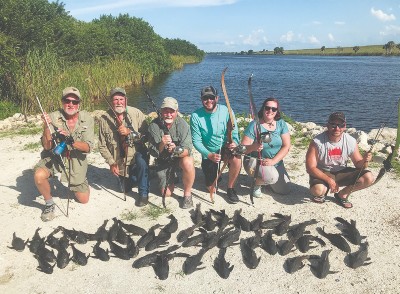
A day’s take on Lake Okeechobee. Left to right, the author, Bill Terry, Bo Slaughter, Tyler and Sierra Receveur, and Kevin Clark.
The next day we slept in, prepped our gear and the two boats, had dinner early, and then set off at dusk for an all-night adventure. Herb Higgins and his wife, Carrie, were to join us for the gator hunt. Terry hooked me up with gear for the hunt, which included a fishing pole handle with a Zebco 808 reel filled with 250# test line tied to an aluminum arrow with a fiberglass shaft inside and fish point on the end. Tied to the reel was a short stretch of rope securely attached to a small marine boat bumper. The handle of the pole was slid into a leather pistol holster on my waist. When time came to shoot, I was told to release the bail and take the shot. If—or when, as Terry assured me— I were to get an arrow into the gator, I was supposed to allow ten to 15 yards of line to run, click the reel to lock it, and toss the pole and reel into the water. The bumper would float, allowing us to find the gator and pull it in for another shot or harpoon. Two lines in the gator make for easier recovering.
The process was to slowly motor around the sloughs with 100,000 candle-power spotlights attached to large 12-volt automotive batteries. Using the halo, which is the lower light given off by the main beam, you approach the gator’s eyes. After getting close enough, the main beam is lowered and you take the shot, which is not always easy, as gators submerge when the full light hits them. Misses are common, but once in a while a gator will sit long enough to get an arrow into it.
We had dozens of opportunities and lots of shots, but by 1 a.m. the gators had made fools of us. I missed two or three and bounced an arrow off a 7-footer as it swam away. The fish point ricocheted off the hard scales—called scutes—on its back, and it simply vanished unharmed.
Around 2 a.m. Tyler and I were on the bow when we came up on a large gator. Terry lowered the light and the gator flipped and headed down. Both of our arrows whistled into splashing water, but neither connected. As we were reeling in our arrows the beast came back for more. Tyler shot and missed and as the gator turned to flee, I shot and connected. As the line started peeling off the reel, I yanked the rod handle out, waited a few seconds, cranked the handle to stop the line, and fired everything overboard. It happened so fast that I didn’t really have any time to think about anything other than what Terry had told me to earlier.
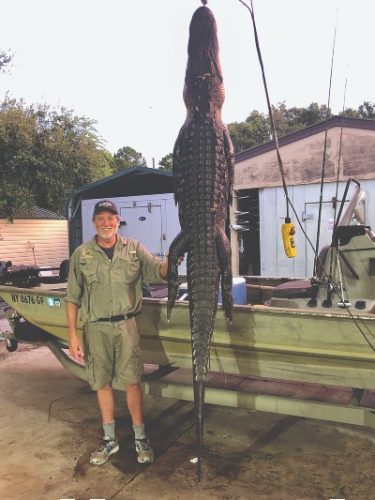
The author took this 9’ 7” alligator the first night out.
After the rush, all fell still—the engine killed, floodlights splayed all over, no yellow buoy. The sound of night birds and insects and the vegetative smell of the organic matter in the water filled my ears and nose. Sweat dripped into my eyes as I scanned the water for the bumper. Stars were twinkling, but the bumper was nowhere to be seen. As the minutes crawled by, I was having a sinking feeling. That’s when Sierra saw the yellow buoy by the shore.
We slowly motored over, Terry grabbed the reel and started to reel in the gator, and I grabbed the harpoon, making damn sure the coiled rope at my feet was in the clear. As the gator got close enough to see, Terry said to hammer down the harpoon, but what we thought was the back was the huge tail. When I plunged down, the gator thrashed, and I missed. It then took off and Terry, who could not keep a hold had to let the reel go. The problem was that there were only a few feet of line between the gator and the reel, and with the depth of the slough 12-14 feet deep, we had no idea where it went. After ten minutes, the darkness started to close all around me again as I wondered if we would ever find the critter. Then, the bumper miraculously appeared in the middle of the slough.
Terry grabbed the reel again and slowly pulled up the line. The scutes on the broad back of the gator appeared through the brown water. I thrust the harpoon into its back and jerked the shaft out as is tore off again. Terry had the bail open and after several yards peeled off, he set it and tossed it into the water. The rope at my feet uncoiled and flew out of the boat, the bumper skyrocketing out last and flying through the air before disappearing under the water. Terry started to motor in the direction the gator had taken. Soon we came upon both bumpers moving away and the large alligator in front swaying side to side on the surface.
Tyler took over the helm while I grabbed the harpoon line and Terry grabbed the reel. Slowly we got the gator to the boat, but it rolled around several times and then attacked the boat’s railing, breaking several teeth off—an incredible sight to behold. When the gator finally eased up and rolled over, Terry handed me the kill arrow.
“Put this in the boiler room!” he said as he smiled at me.
The wood arrow with a broadhead sank deep, and the water turned red. After several minutes, and another boat chomping by the gator, Terry had its jaws secured over the gunwale. I taped up its mouth, and Terry handed me a special knife.
“You need to finish the job. You have to pith him before we can boat him!” he said to me.
It took a few minutes, but I found the spot at the top of its spine and severed the spinal cord. The gator went limp, and three of us hauled it into the boat. An hour later, Tyler nailed a 7-plus footer with a perfect shot to the vitals as it swam on top of the water next to the boat. The rest of the morning I was on cloud nine as I stared at the huge alligator, reliving the event.
The next three nights I spent helping out on one of the boats. All eight tags had been filled by the group. Herb Higgins landed the largest gator, which measured at 10’ 5”, while mine was an easy 9’ 7”. I had the most fun on a hunt with great friends since the last February with the Marfa Marauders chasing javelina in Texas, but that story is for another time.
Our last evening, we all went out for a final dinner together. As we said our goodbyes in the parking lot, Terry pulled me aside and said, “Was the hunt everything you expected, Teej?”
I paused and watched the movie of the week run through my mind. “Terry, I had no preconceptions of what it would be like. However, it was a hell of a lot more fun than I ever expected…and I want to do it again someday!” I replied.
T.J. lives on a small ranch outside of Boise, Idaho with his wife, Robin, and two special needs cats who both were adopted from the wilds. By the time this prints, he will have undergone major repairs of several torn rotator cuff tendons, as well as a torn bicep tendon, in his right shoulder. He plans on diving into rehab and getting back out with his longbow by fall.
Bowhunting Alligators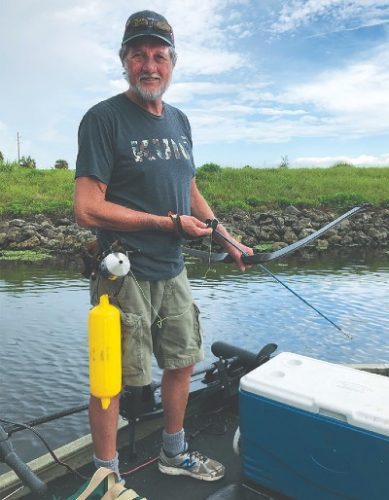
Although I was lucky and went with long-time friends who knew the ropes of alligator hunting, there are several guides and outfitters in Florida who specialize in bowhunting these prehistoric animals. Rates vary widely, depending on whether you want meals and lodging included, but expect to pay anywhere from $800 to $3500 for a 2-day/2-night hunt, which includes an alligator up to 10’, after which there may be an extra trophy fee. Do an Internet search for bowhunting Florida alligators and you will find dozens of options. Most will have the gear you will need, but make sure or else you will have to bring your own.
Alligator meat is great table fare, although the flavor is quite light. It takes spices and marinades well, so don’t over-spice it. I brought home 50#, packed in 1# and 5# packages of clean, cubed, and flash-frozen gator meat. Most people bread and deep fry alligator. However, I prefer to keep it simple, and lightly toss the fillets in my own spices and a mixture of flour and baking powder, the latter of which adds a little crunch to the outside. I then sauté the fillets in butter, with about a tablespoon of avocado oil to keep the butter from burning, and half a dozen crushed garlic cloves. Everyone comes back for seconds.
Armored Catfish
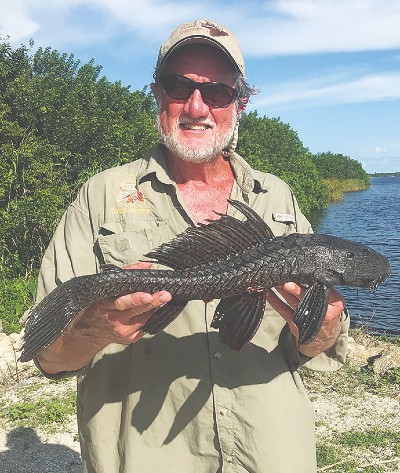
Basic bowfishing gear will work perfectly well for armored catfish, as well as other non-game fish. I prefer a simple fiberglass shaft with a Muzzy or similar fish head that allows you to loosen the tip and reverse the barbs for easy removal from game. I use an AMS Bowfishing Retriever reel mounted onto a Great Northern Bowhunting Traditional Gadget Adapter on my Black Widow longbow. Bring extra arrows, as you can break tips or shafts shooting at fish over rocks or, as I have done several times with a Zebco reel, shooting without opening the bail! It’s an awful feeling to watch one of those expensive fish arrows disappear into the water for good.
I was told that armored catfish were not edible. However, after researching sites from all over the world, I found the opposite is true. It’s considered a delicacy in many Caribbean cultures, as well as South American and Southeast Asian countries. I found myriad recipes for preparing them. The three basic cooking styles are boiling in the shell, roasting in foil, or fileting them for grilling on the half shell. There are many videos on YouTube showing how to prepare, skin, cook, and serve them. Most people say they taste as good as other catfish, but with the consistency of lobster.
- Bill and Bo ganged up to bag this gar while fishing for bass the first day out on the water.
- This giant mullet presented a fast moving target.
- Giant wild talapia infest Lake Okeechobee and make for great bowfishing…and eating.
- Armored catfish get their name from the beautiful hard plates connected by elastic membrane that sur- round the top and sides of the fish.
- Sierra and Tyler with their alligators taken the same evening.
- Sierra and Tyler with their alligators taken the same evening.
- Herb Higgins and Terry Receveur with Herb’s 10’ 5” alligator, the largest one taken on the hunt.
- The business end of Terry’s alligator harpoon.


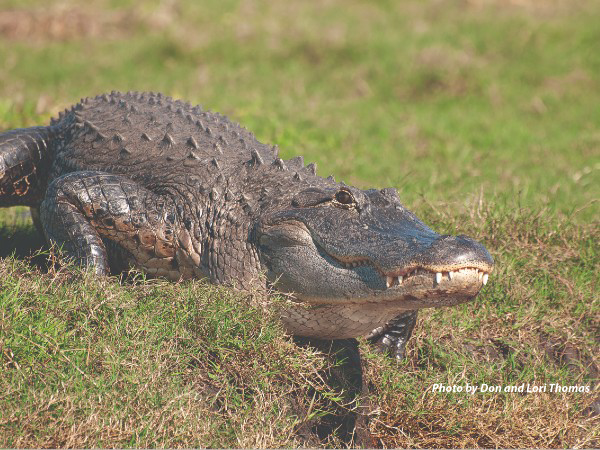
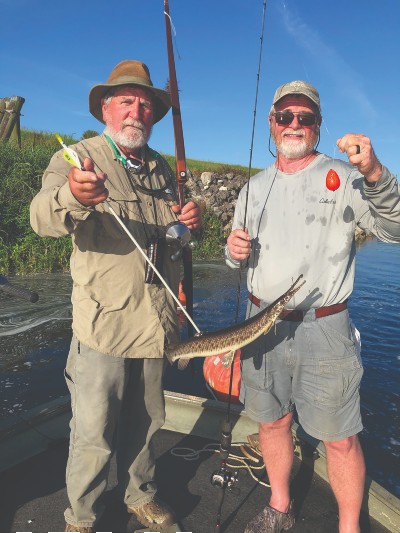
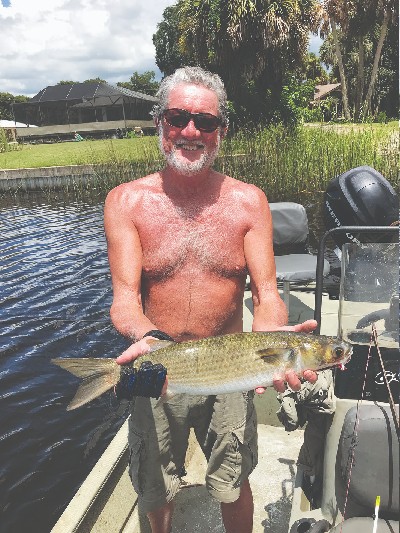
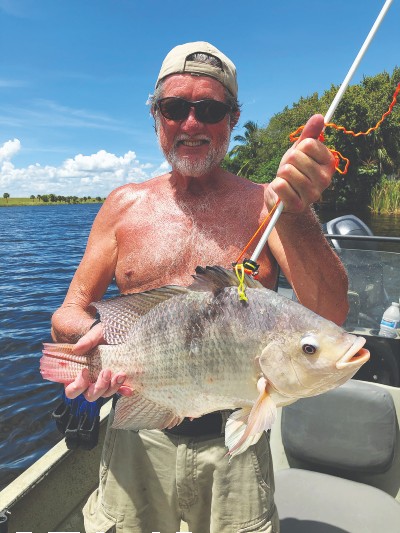
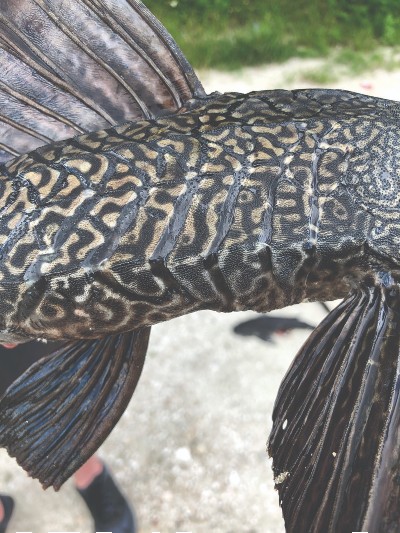
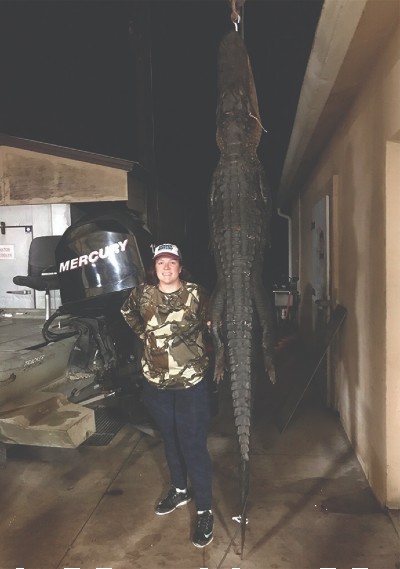
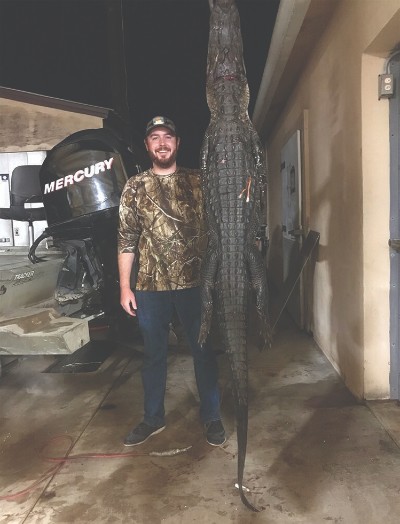

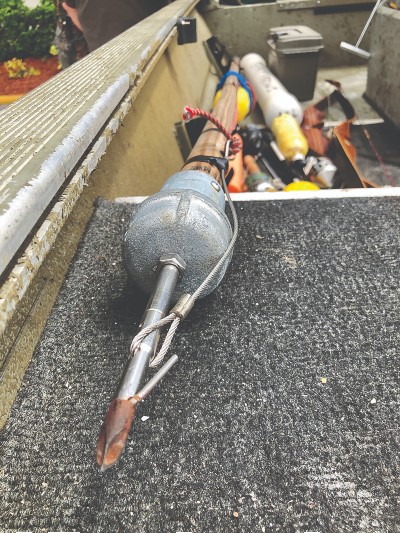


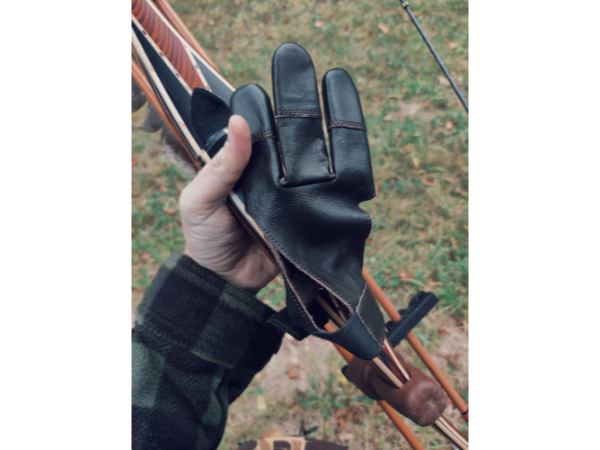

Leave A Comment